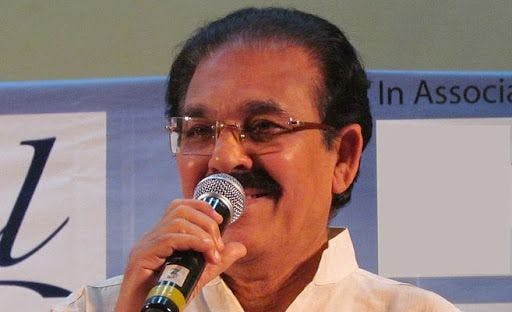Singer-songwriter VM Kutty, who died aged 86 on October 13, was a synonym for Maappilappaattu, a popular music genre in Kerala.
VM Kutty, who modernised, popularised and personified Maappilappattu, a form of subaltern folk music that had been confined to the Muslim community (the Maappilas) in Kerala’s Malabar region as well as Lakshadweep before he came on stage, gave character, depth and universal appeal to the genre.
His impact on the genre was so deep that for over a half-century, V. Mohammed Kutty–as a singer, songwriter, music composer and brand ambassador—had become a synonym for Maappilappaattu. Thousands flocked to his gaana melas, where he entertained the audiences with his songs as well as stage mannerisms.
I knew VM Kutty as a reader of his novel while I was in high school. His Kidapparakal (bedrooms) was serialised in the Malayalam weekly magazine Chandrika back in the 1960s, along with his own illustrations. Later, I came to know that apart from writing novels and drawing pictures, he was also a fine singer. As a child, he trained as a Maappilappaattu singer in his native Pulikkal village, some 25 km from the city of Kozhikode. He has written a dozen books, and I penned the foreword for the book Maappilappaattinte Lokam (The World of Maappilappaattu).
Great Lineage
Maappilappaattu has a long tradition going back to many centuries. The oldest known Maappilappaattu work is Muhiyudheen Maala, written in the Arabic-Malayalam script by Khazi Mohammed in 1607. There have been hundreds of songs made by anonymous poets and handed down the centuries orally. Moyinkutty Vaidyar’s Badarul Muneer Husnul Jamal, a romantic tragedy written in 1872, was extremely popular among generations of Muslim youth of Malabar. Pulikkottil Hyder’s Nari Naayaattu (Tiger Hunt) and other songs based on day-to-daylife were very popular too. Until the late 20th century, Maappilappaattu was an essential item at weddings.
The thousands of Maappila youths deported to the Andamans by the British Raj in the wake of the Malabar Rebellion of 1921 carried the Maappilappaattu tradition to the Andaman & Nicobar Islands.
It was the song ‘’Kaayalarikathu valayerinjappol…” in the 1954 Malayalam film Neelakkuyil that brought Maappilappattu to the mainstream Kerala society. `Kaayalarikathu’ was written by P. Bhaskaran and sung by K. Raghavan. Until then, Maappilappaattu had been written, sung and practised by Maappilas, for Maappilas and of Maappilas. Kutty, through his thousands of stage performances in Kerala and the Gulf countries could take the genre across the religious barriers. He also encouraged a stream of women singers to go on stage and make their mark. He teamed up with Vilayil Valsala (Faseela) and for decades the public spaces and walls of Malabar used to sport `VM Kutty & Vilayil Valsala Gaana Mela’ posters.
It was the song ‘’Kaayalarikathu valayerinjappol…” in the 1954 Malayalam film Neelakkuyil that brought Maappilappattu to the mainstream Kerala society. `Kaayalarikathu’ was written by P. Bhaskaran and sung by K. Raghavan. Until then, Maappilappaattu had been written, sung and practised by Maappilas, for Maappilas and of Maappilas. Kutty, through his thousands of stage performances in Kerala and the Gulf countries could take the genre across the religious barriers. He also encouraged a stream of women singers to go on stage and make their mark. He teamed up with Vilayil Valsala (Faseela) and for decades the public spaces and walls of Malabar used to sport `VM Kutty & Vilayil Valsala Gaana Mela’ posters.
It was the song ‘’Kaayalarikathu valayerinjappol…” in the 1954 Malayalam film Neelakkuyil that brought Maappilappattu to the mainstream Kerala society. `Kaayalarikathu’ was written by P. Bhaskaran and sung by K. Raghavan. Until then, Maappilappaattu had been written, sung and practised by Maappilas, for Maappilas and of Maappilas. Kutty, through his thousands of stage performances in Kerala and the Gulf countries could take the genre across the religious barriers. He also encouraged a stream of women singers to go on stage and make their mark. He teamed up with Vilayil Valsala (Faseela) and for decades the public spaces and walls of Malabar used to sport `VM Kutty & Vilayil Valsala Gaana Mela’ posters.
Pastoral love, love pangs, romantic pain, and separation have always been a staple topic of Maappilappaattu. However, the genre also highlighted other facets of life, including the daily hardships of the working class. Historic battles, heroics of warriors, religious issues and paeans to beautiful women were frequently featured. One branch of Maappilappaattu was entirely devoted to weddings, bedrooms and honeymoons. Humour and parody were a strong presence in the paattu tradition. The Maappila Ramayanam, which I unearthed in July 1976, was a humorous retelling of some of the tales of the Ramayana in the Maappilappaattu tradition.
Music over lyrics
Music always took precedence over literary aesthetics as Maappilappaattu was meant to be sung and not read. It has its own rules of tunes, rhythms and rhymes (such as: kambi, kazhuthu, vaalkambi, and vaalinmel kambi), which differentiated it from other music genres. Music, like football, has always been an essential part of the Maappila life, though a miniscule section of religious ideologues now looks down upon music.
One stream of Maappilappaattu, the Kathu (letter) paattu, has got a huge boost since the 1970s because of the outflow of Maappila youth to the Gulf countries looking for livelihoods. It was an emotional response to the pain of separation of young couples who were forced to live apart thousands of miles away for years together. Kutty was hugely popular among the lakhs of Malayali workers in the Gulf because his songs gave voice to their hopes and pains.
Through his efforts to modernize and stylize Maappilappattu for over half a century, Kutty could pull the genre out of the confines of Maappila homes and put it on stage as a performing art. And, also raise the social status and earnings of the artists.

